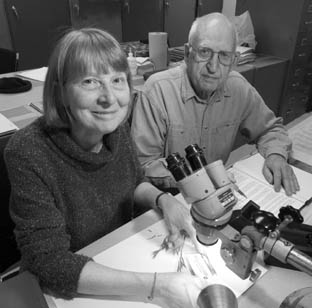
|
Pressing
Plants, Painting Pixels:
One can only assume that their discussion is like hundreds, perhaps thousands, of others that have taken place between plant collectors whose pressed and labeled specimens are preserved in the shelves that surround Backus and Polloni. The room in which they work houses the Marine Biological Laboratory (MBL) Herbarium, formerly part of the George M. Gray Museum. Over 8,000 specimens--some dating back to 1873--reside here. The collection includes approximately 7,000 vascular plants and 1,000 non-vascular plants, the latter primarily marine algae of Cape Cod, the Elizabeth Islands, Martha's Vineyard, and Nantucket. Early contributors to the collection read like a "who's who" of botanists and naturalists from the late 19th and early 20th centuries. Names like David Starr Jordan, renowned ichthyologist, naturalist and educator, who served as Stanford University's first president and the namesake for a NOAA ship; W.G. Farlow, eminent Harvard mycologist and phycologist, for whom Harvard's Farlow Library and Herbarium is named. And, M.L. Fernald, director of Harvard's Gray Herbarium, who co-edited the eighth edition of Asa Gray's Manual of Botany, the original--and still highly regarded--guide to U.S. flora east of the Rocky Mountains. These botanists described and classified the kinds of plants that exist in the world, says Richard Backus, the herbarium's curator emeritus. When the MBL/WHOI Library assumed responsibility for the collection in 2002, it recognized its importance as a resource. After investigating digitized herbaria, the MBL/WHOI Library entered into a joint venture with the Northeast Algal Society (NEAS) to digitize the seaweed collection. With support from WHOI Sea Grant, library staff purchased a scanner and, with the help of dedicated volunteers, has digitized nearly all of the marine algal species to date. Amy Stout, the digital systems and services coordinator at MBL, calls the undertaking "a perfect marriage of technology and history." Stout oversees the web side of the project and coordinates the volunteers and archiving of specimens to be scanned. Joe deVeer, MBL/WHOI Library technical systems coordinator, is in charge of analyzing and cataloguing specimens. Digitizing the collection, says acting curator Polloni, will
"get the collection out of the closet." Literally. For nearly
130 years, the collection's
specimens have been stored in various locations, most recently
within WHOI's Data Library and Archives--a vast improvement over
the stuffy
MBL attic they once occupied. Prior to the digitization project,
one would need to make an appointment to access the collection,
then sift through a filing system that, though well-organized,
isn't for everyone. Now, the herbarium can serve a worldwide audience.
"There has been a lot of interest in invasive species lately,"
says Polloni. "We've had inquiries from other parts of the country
who
are interested in searching the collection to see when a particular
species started appearing." Closer to home, then--Massachusetts state botanist Bruce Sorrie, working with Cape Cod botanist Richard LeBlond, visited the herbarium to prepare The Vascular Plants of Massachusetts: A County Checklist, a record of Barnstable County plants and their distribution. While doing that research, Sorrie and LeBlond re-identified some of the collection's records--a significant contribution, says Backus. Today, there are only a handful of regular contributors to the herbarium's collection; most are members of the Botanical Club of Cape Cod and the Islands who principally collect vascular plants. Backus is among them; he has added many specimens to the collection, including more than a hundred sheets after the 1999 Penikese Island survey. Penikese Island, the last island in the Elizabeth Island chain off Woods Hole, figures prominently in the MBL Herbarium collection: in 1873, naturalist Louis Agassiz founded the Anderson School of Natural History on the island. Jordan, one of Agassiz's students, made a Penikese Island Survey in 1873. And Edwin Moul, a noted Pennsylvania botanist who summered and later retired in Woods Hole, added numerous samples from a 1947 Penikese survey. When Jordan died in 1931, he left behind a lot of stuff, says Backus. "Someone came upon the seaweeds he'd collected on Penikese in 1873. Whoever it was--bless their heart--sent them to the MBL and they have been part of the herbarium collection ever since." While Jordan's samples had a storybook homecoming, they are not the only samples to come to the collection serendipitously. A 1941 Woods Hole collection, made by Jackie Waldron, an MBL student of botanist William Randolph Taylor, was recently sent to the herbarium by the Virginia Institute of Marine Sciences. And, not long ago, a New Hampshire bookstore was referred to herbarium staff after buying what they thought were old photo albums.
|
